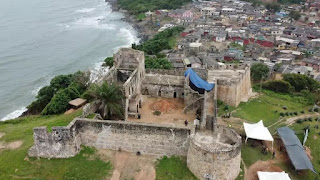 |
| Image |
This article explores the historical
significance of Fort Amsterdam, also known as Fort Kormantine, as the first
English slave fort in Africa. Situated on Ghana's coast, this fort played a
crucial role in the transatlantic slave trade during the 17th and 18th
centuries. Through an examination of historical records, archeological
evidence, this article sheds light on the establishment, usage, and eventual
uncovering of this monumental structure. This uncovering incident started on June
and ended on the July due to their research.
Archeological evidence, including pottery fragments,
coins, and other artifacts, has confirmed the fort's transformation into an
English slave fort. These findings strengthen the historical accounts and oral
traditions that assert Fort Amsterdam's critical role in the transatlantic
slave trade.
 |
| Prof Chistopher DeCorse(C) is leading the team of archaeologists in Ghana |
Archaeologist Christopher DeCorse has exam rare artifacts found in Ghana's ruins of Fort Amsterdam, which are believed to be the remains of an older fort called Kormantine. These fragments, unearthed from compacted soil, offer clues to a lost past and suggest the existence of the first English outpost in Africa. The professor's team is excavating these remains with rapid activity. Archaeologists are working on a site called Fort Kormantine, dating back to the 17th century. The site was located on the Atlantic coast, just as Europeans transitioned from gold to human trade, affecting Africa. The discovery may shed light on the lives of early traders, their activities, and the impact on the community. The discovery may shed light on the history of European exploitation and human cruelty in Ghana's coastal fishing towns, which are still haunted by the slave forts along the Gold Coast.
 |
| The site of the dig,under the blue canopy,is insidefort Amsterdam built by the Dutch |
Fort Kormantine, built by the English in 1631, was a
crucial location for the slave trade in Africa. It served as a trading post for
gold and ivory, and was a holding point for those kidnapped in West Africa
before being shipped to the Caribbean for sugar production. The Dutch seized
the fort in 1663, but exact location remains unknown due to its status as a
World Heritage Site. However, 2019 digs near Fort Amsterdam, revealing early
17th-century artifacts, suggest its possible location.
 |
| Nigerian Omokolade Omigubule |
In nutshell, the uncovering of Fort Amsterdam, also
known as Fort Kormantine, has shed light on its historical significance as the
first English slave fort in Africa. The fort's transformation from Dutch
trading post to English slave fort underscores the complexities of European
colonization and the brutal legacy of the transatlantic slave trade. The
archeological evidence by (Christopher R. DeCorse),
combined with historical records and scholarly research, provide a
comprehensive understanding of Fort Amsterdam's establishment, usage, and
uncovering on Ghana's coast.
WATCH OUR FRIST TOUR VIDEO
OVER VIEW OF FORT AMSTERDAM
Credit:BBC
Source:markneswin.blogspot.com





0 Comments